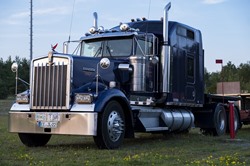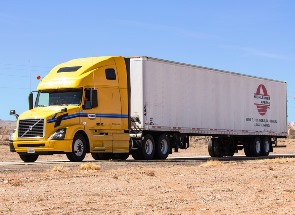How to Pick the Right Trucker School near Olney Montana
 Congrats on your decision to become a truck driver and enroll in a CDL school near Olney MT. Maybe it has always been your fantasy to hit the open highway while driving a huge tractor trailer. Or possibly you have conducted some research and have found that a career as a truck driver provides excellent wages and flexible job opportunities. Whatever your reason is, it’s essential to get the appropriate training by enrolling in the right CDL school in your area. When evaluating your options, there are a number of variables that you’ll need to consider before making your ultimate choice. Location will undoubtedly be an issue, particularly if you have to commute from your Olney home. The expense will also be important, but picking a school based solely on price is not the best method to guarantee you’ll get the proper training. Just remember, your goal is to learn the knowledge and skills that will allow you to pass the CDL examinations and become a professional truck driver. So keeping that purpose in mind, just how do you pick a truck driving school? The answer to that question is what we are going to cover in the balance of this article. But first, we are going to discuss a little bit about which CDL license you will eventually need.
Congrats on your decision to become a truck driver and enroll in a CDL school near Olney MT. Maybe it has always been your fantasy to hit the open highway while driving a huge tractor trailer. Or possibly you have conducted some research and have found that a career as a truck driver provides excellent wages and flexible job opportunities. Whatever your reason is, it’s essential to get the appropriate training by enrolling in the right CDL school in your area. When evaluating your options, there are a number of variables that you’ll need to consider before making your ultimate choice. Location will undoubtedly be an issue, particularly if you have to commute from your Olney home. The expense will also be important, but picking a school based solely on price is not the best method to guarantee you’ll get the proper training. Just remember, your goal is to learn the knowledge and skills that will allow you to pass the CDL examinations and become a professional truck driver. So keeping that purpose in mind, just how do you pick a truck driving school? The answer to that question is what we are going to cover in the balance of this article. But first, we are going to discuss a little bit about which CDL license you will eventually need.
Which CDL Should You Get?
 To operate commercial vehicles legally within the United States and Olney MT, an operator needs to attain a CDL (Commercial Driver’s License). The three license classes that one can qualify for are Class A, Class B and Class C. Given that the subject of this article is how to choose a truck driving school, we will focus on Class A and Class B licenses. What differentiates each class of CDL is the kind of vehicle that the driver can operate in addition to the GVWR (Gross Vehicle Weight Rating) or GCWR (Gross Combination Weight Rating). Below are brief explanations for the 2 classes.
To operate commercial vehicles legally within the United States and Olney MT, an operator needs to attain a CDL (Commercial Driver’s License). The three license classes that one can qualify for are Class A, Class B and Class C. Given that the subject of this article is how to choose a truck driving school, we will focus on Class A and Class B licenses. What differentiates each class of CDL is the kind of vehicle that the driver can operate in addition to the GVWR (Gross Vehicle Weight Rating) or GCWR (Gross Combination Weight Rating). Below are brief explanations for the 2 classes.
Class A CDL. A Class A CDL is required to operate any vehicle that has a GCWR of greater than 26,000 lbs., including a towed vehicle of greater than 10,000 lbs. A few of the vehicles that operators may be able to drive with Class A licenses are:
- Interstate or Intrastate Tractor Trailers
- Trucks with Double or Triple Trailers
- Tanker Trucks
- Livestock Carriers
- Class B and Class C Vehicles
Class B CDL. A Class B CDL is needed to drive single vehicles having a GVWR of greater than 26,000 lbs., or a GCWR of greater than 26,000 lbs. including a towed vehicle weighing up to 10,000 lbs. Several of the vehicles that operators may be qualified to drive with Class B licenses are:
- Tractor Trailers
- Dump Trucks
- Cement Mixers
- Large Buses
- Class C Vehicles
Both Class A and Class B CDLs might also need endorsements to operate specific types of vehicles, for instance passenger or school buses. And a Class A licensee, with the proper required endorsements, may operate any vehicle that a Class B license holder is authorized to operate.
Click Here to Get Free Information on Truck Driving Schools Near You!
How to Research a Trucking School
 As soon as you have determined which Commercial Drivers License you wish to pursue, you can start the process of assessing the Olney MT truck driving schools that you are looking at. As already discussed, cost and location will undoubtedly be your primary concerns. But it can’t be emphasized enough that they should not be your only considerations. Other factors, for instance the experience of the instructors or the reputations of the schools are similarly if not more important. So below are several more things that you should research while carrying out your due diligence prior to choosing, and especially paying for, your truck driver training.
As soon as you have determined which Commercial Drivers License you wish to pursue, you can start the process of assessing the Olney MT truck driving schools that you are looking at. As already discussed, cost and location will undoubtedly be your primary concerns. But it can’t be emphasized enough that they should not be your only considerations. Other factors, for instance the experience of the instructors or the reputations of the schools are similarly if not more important. So below are several more things that you should research while carrying out your due diligence prior to choosing, and especially paying for, your truck driver training.
Are the Schools Accredited or Certified ? Very few trucking schools in the Olney MT area are accredited due to the stringent process and expense to the schools. On the other hand, certification is more prevalent and is provided by the Professional Truck Driver Institute (PTDI). A school is not required to become certified, but there are a number of advantages. Prospective students know that the training will be of the highest standard, and that they will get plenty of driving time. For example, PTDI calls for 44 hours of actual driving time, not ride-alongs or simulations. So if a school’s course is certified (the course, not the school is certified), students know that the training and curriculum will comply with the very high standards set by PTDI.
How Long in Operation? One clue to help determine the quality of a truck driver school is how long it has been in business. A negatively reviewed or a fly by night school usually will not be in business very long, so longevity is a plus. Having said that, even the best of Olney MT schools had to begin from their first day of training, so use it as one of several qualifications. You can also learn what the school’s track record is regarding successful licensing and job placement of its graduates. If a school won’t supply those numbers, search elsewhere. The schools should additionally maintain associations with local and national trucking companies. Having numerous contacts not only affirms a superior reputation within the trade, but also boosts their job placement program for graduates. It also wouldn’t hurt to contact the Montana licensing authority to make sure that the CDL trucking schools you are researching are in good standing.
How Effective is the Training? At a minimum, the schools must be licensed in Montana and employ teachers that are trained and experienced. We will talk more about the instructors in the next section. Also, the student to instructor proportion should be no higher than 4 to 1. If it’s any greater, then students will not be receiving the personal instruction they will need. This is particularly true regarding the one-on-one instruction for behind the wheel training. And be critical of any school that insists it can teach you to be a truck driver in a relatively short time frame. Learning to be an operator and to drive a tractor trailer professionally takes time. Most Olney MT schools provide training programs that run from three weeks to as long as two months, depending on the license class or kind of vehicle.
How Good are the Trainers? As previously mentioned, it’s essential that the teachers are qualified to teach driving techniques and experienced as both drivers and instructors. Although a number of states have minimum driving time criteria to be certified as an instructor, the more professional driving experience an instructor has the better. It’s also crucial that the teachers keep current with industry advancements or any new laws or changes in regulations. Evaluating teachers might be a little more intuitive than other standards, and possibly the best method is to check out the school and talk to the instructors face to face. You can also talk to some of the students completing the training and ask if they are satisfied with the level of instruction and the teacher’s ability to train them.
Plenty of Driving Time? Above all else, a good truck driver school will furnish ample driving time to its students. After all, isn’t that what it’s all about? Driving time is the actual time spent behind the wheel driving a truck. Although the use of ride-a-longs with other students and simulators are important training tools, they are no substitute for actual driving. The more instruction that a student receives behind the wheel, the better driver he or she will be. Although driving time can vary between schools, a reasonable benchmark is a minimum of 32 hours. If the school is PTDI certified, it will furnish a minimum of 44 hours of driving time. Contact the Olney MT schools you are considering and ask how much driving time they provide.
Are they Independent or Captive ? You can receive free or discounted training from a number of trucking schools if you enter into an agreement to be a driver for a particular carrier for a defined amount of time. This is what’s known as contract training, and the schools that provide it are called captives. So rather than maintaining relationships with many different trucking lines that they can refer their students to, captives only work with one company. The tradeoff is receiving free or less expensive training by giving up the flexibility to initially work wherever you have an opportunity. Clearly contract training has the potential to limit your income prospects when beginning your new career. But for many it may be the ideal way to receive affordable training. Just be sure to inquire if the Olney MT schools you are considering are captive or independent so that you can make an informed decision.
Offer CDL Testing Onsite? There are several states that will allow 3rd party CDL testing onsite of truck driver schools for its grads. If onsite testing is available in Montana, ask if the schools you are reviewing are DMV certified to provide it. One benefit is that it is more convenient than battling with graduates of competing schools for test times at Montana testing locations. It is also an indicator that the DMV views the authorized schools to be of a higher quality.
Are the Class Times Convenient? As previously noted, CDL training is just one to two months in length. With such a short duration, it’s essential that the Olney MT school you select provides flexibility for both the scheduling of classes and the curriculum. For example, if you’re having a hard time learning a particular driving maneuver, then the teacher should be prepared to devote more time with you until you have it mastered. And if you’re still working while attending training, then the class scheduling needs to be flexible enough to fit in working hours or other responsibilities.
Is Job Placement Provided? The moment you have acquired your CDL license after graduating from truck driver school, you will be anxious to begin your new career. Confirm that the schools you are looking at have job placement programs. Find out what their job placement ratio is and what average salary their grads start at. Also, ask which national and local trucking companies their graduates are placed with for hiring. If a school has a poor job placement rate or not many Olney MT employers hiring their grads, it may be a sign to look elsewhere.
Is Financial Assistance Provided? Trucking schools are comparable to colleges and other Olney MT area trade or technical schools when it comes to loans and other forms of financial aid being available. Ask if the schools you are assessing have a financial assistance department, or at least someone who can help you get through the options and forms that need to be completed.
CDL Trucking School Olney Montana
 Choosing the right truck driving school is an essential first step to starting your new occupation as a local or long distance truck driver. The skill sets that you will learn at school will be those that mold a new career behind the wheel. There are several options offered and understanding them is critical to a new driver’s success. You originally came to our website because of your interest in CDL Trucking School and wanting information on the topic CDL Truck Training. But first and foremost, you must receive the necessary training in order to drive a big commercial vehicle in a professional and safe fashion. If you are lacking cash or financing, you may want to consider a captive school. You will pay a reduced or in some cases no tuition by agreeing to drive for their contracted carrier. Or you can choose an independent trucker school and have the option of driving for the trucking company of your choosing, or one of many affiliated with the school. It’s your decision. But regardless of how you obtain your training, you will in the near future be entering an industry that helps America move as a professional trucker in Olney MT.
Choosing the right truck driving school is an essential first step to starting your new occupation as a local or long distance truck driver. The skill sets that you will learn at school will be those that mold a new career behind the wheel. There are several options offered and understanding them is critical to a new driver’s success. You originally came to our website because of your interest in CDL Trucking School and wanting information on the topic CDL Truck Training. But first and foremost, you must receive the necessary training in order to drive a big commercial vehicle in a professional and safe fashion. If you are lacking cash or financing, you may want to consider a captive school. You will pay a reduced or in some cases no tuition by agreeing to drive for their contracted carrier. Or you can choose an independent trucker school and have the option of driving for the trucking company of your choosing, or one of many affiliated with the school. It’s your decision. But regardless of how you obtain your training, you will in the near future be entering an industry that helps America move as a professional trucker in Olney MT.
Truck On in These Other Montana Locations
Olney's lesions
Olney's lesions, also known as NMDA receptor antagonist neurotoxicity (NAN), are a potential form of brain damage due to drugs that have been studied experimentally and have produced neuronal damage, yet are administered by doctors to humans in the settings of pharmacotherapy and of anesthesia. They are named after John Olney, who conducted a study in 1989 to investigate neurotoxicity caused by PCP and related drugs.[1] They are important for two reasons. Firstly, NMDA receptor antagonist drugs are not only street drugs that are taken recreationally, they are also physician-prescribed drugs for therapeutic treatment of human diseases such as memantine for Alzheimer's disease and amantadine for Parkinson's disease. Secondly in the field of anesthesiology, the dissociative anesthesia of many general anesthetics is due to NMDA receptor antagonist properties. Because the neuronal vacuolation of Olney's lesions evolves into neuronal necrosis or death of neurons, it is important to determine whether Olney's lesions occur in humans, not only in experimental animals. The essential question is whether an NMDA receptor antagonist drug is to be considered a human neurotoxin or not. The patient safety implications for pharmacotherapy and for anesthesia would each be profound, if the answer is affirmative.
In 1989, Olney et al. discovered that neuronal vacuolation and other cytotoxic changes ("lesions") occurred in brains of rats administered NMDA antagonists, including PCP, MK-801 (dizocilpine) and ketamine.[2] Examination of neurons in the posterior cingulate and retrosplenial cortices by electron micrograph revealed apparent lytic breakdown of mitochondria in the large vacuoles which had become apparent 2 hours after administration of an NMDA antagonist. After administration of 1.0 (mg/kg sc) MK-801 to rats, these neurotoxic changes became more apparent until about 12 hours post-dose, but the morphology of most cells appeared normal by light microscope about 24 hours post-dose. With 10 (mg/kg sc) doses of MK-801, the vacuolation reaction was still visible by light microscope 48 hours post-dose. After repeated doses of the NMDA antagonists MK-801 and PCP, the vacuolation reaction appeared consistent with the reaction after a single dose, so there was no evidence of a cumulative neurotoxic effect or that the reaction proceeded to an irreversible stage with repeated doses. The lowest doses of ketamine and tiletamine that produced neurotoxic changes visible by light microscope 4 hours post dose were 40 (mg/kg sc) and 10 (mg/kg sc), respectively. The potency of the drugs in producing these neurotoxic changes corresponded with their potency as NMDA antagonists: i.e. MK-801 > PCP > tiletamine > ketamine.
Researcher Roland N. Auer conducted similar studies to look at the correlation between age and sex and the development of NMDA receptor antagonist neurotoxicity in test rats. Older rats experienced a much higher mortality rate after the development of NAN. Female rats were found, at all ages, to have a higher incidence of necrotic (dead) neurons as a result of NAN.[3]
Business Results 1 - 10 of 1

